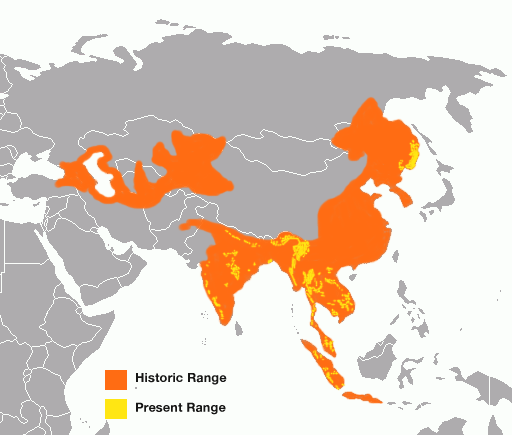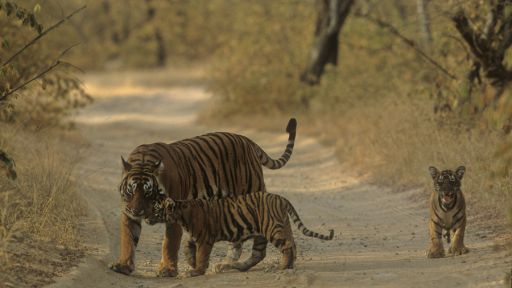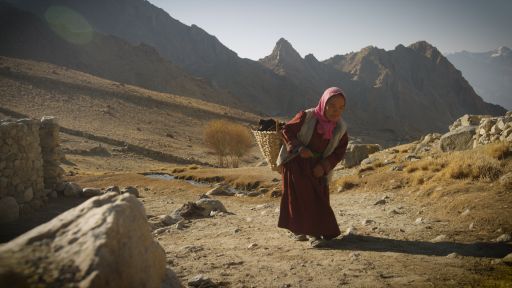Tigers are the largest of the big cats, the most popular, and the most at-risk for extinction. Over the past 100 years, tiger populations have seen a decrease of around 95%. While exact counts are difficult to make, it has been widely accepted that perhaps as few as 3,200 tigers are currently in the wild. Even India, often regarded as the nation with the most tigers, has seen a significant drop in its Bengal tiger population over the past eight years, from 3,600 to just 1,400.
That we might see a day when tigers no longer roam the planet is not out of the question. Three of the nine subspecies of tiger are already extinct: the Bali tiger, limited to the island of Bali and the smallest of the subspecies, the Javan tiger found in the Indonesian island of Java, and the Caspian tiger, which – although nearly identical to the Siberian tiger – is still recognized as its own subspecies. All three became extinct within the past 80 years. Hunting and poaching, and habitat destruction have been largely to blame for their disappearance. And it is these factors that are also putting the remaining six subspecies at risk. The Bengal, Indochinese, Malayan, Sumatran, Siberian, and South China tigers continue to be pushed into small pockets of land as human development encroaches on the tiger’s natural habitat. We are at what has been referred to as a tipping point – a critical time when humans must step-up and institute policies and regulations to help the dwindling tiger population. Without such a concerted effort, the remaining six species will meet a fate similar to that of the Bali, Javan, and Caspian tigers. Few animals are in such dire straights.
The historic tiger range included most of Asia – from Turkey to the far eastern coast of Russia. Since the turn of the twentieth century, tigers have lost about 93% of that range. Most tiger populations are now found in southern Asia – Bangladesh, Bhutan, Cambodia, China, India, Indonesia, Laos, Malaysia, Myanmar, Nepal and Thailand, and Vietnam – and in the outskirts of northeast Russia. Though the list of countries may seem long, little land is dedicated to wild tigers. In these nations, tigers are generally confined to a series of reserves – areas of land deemed suitable and set aside for tigers and other indigenous wildlife. The first wave of tiger reserves was born in the mid-to-late twentieth century in response to a heightened awareness of diminishing tiger numbers. India’s first nine reserves were the result of an alarming 1972 tiger census that reported population numbers in the nation to be as low as 2,400. (That number has steadily risen, until recently.) While reserves are important, they aren’t perfect. Some reserves are poorly managed, most are too small, and many are isolated from other neighboring reserves. Tiger populations are highly fragmented – a tiger family living in one park tends to be isolated from tiger families living in other nearby reserves. According to filmmaker and tiger conservationist Colin Stafford-Johnson, restricting tigers’ geographical range is a serious issue, not only because it cuts the genetic variation of offspring, but because tigers are, by nature, meant to roam.
Stafford-Johnson spent 600 days filming a tiger family in India’s Ranthambhore National Park. One of the tigers Stafford-Johnson follows, Broken Tail, inexplicably left his home in Ranthambhore. After traveling over 100 miles outside the park, he was killed by a train in the city of Darra. For Stafford-Johnson, Broken Tail’s story reinforces what is painfully obvious – Tigers need more space. Sizable tropical and subtropical forests need to be zoned for tigers, and existing reserves need to be connected, creating long stretches of land for tigers to safely pass through. Without such designated land, tiger populations will remain in jeopardy.
If scientists are right and we are indeed in the midst of a tipping point for tigers, it is only a matter of time before the future of the tiger is sealed. While there is much that looks grim about the situation, as long as there remains any possibility to effect positive change for the world’s tigers, there is hope. Stafford-Johnson sees reason to be optimistic. Authorities have become better at tracking tigers, and their movements have shown that many tigers don’t stay within the confines of the park. Studies like this back the notion that tigers need a much wider geographical range than what most parks offer. And since the film aired, Darra Sanctuary has been designated a national park. Focusing on these small wins is key for Stafford-Johnson. “Once you lose your optimism, you might as well give up.”













